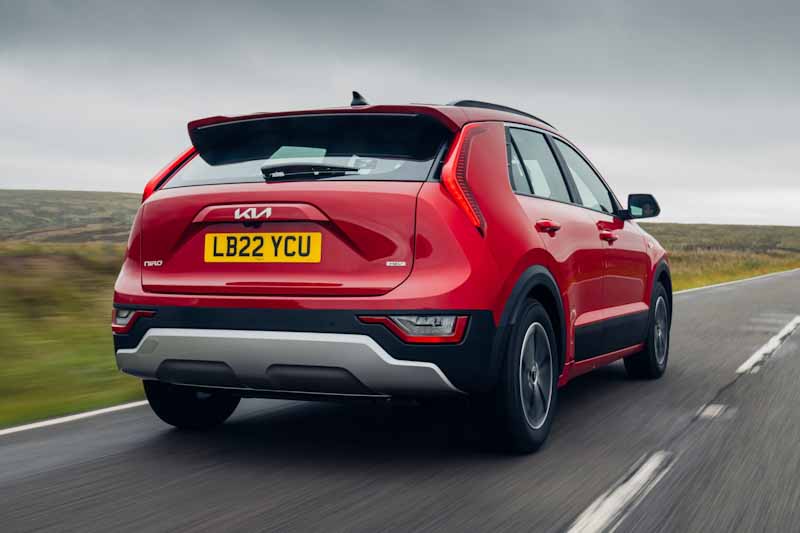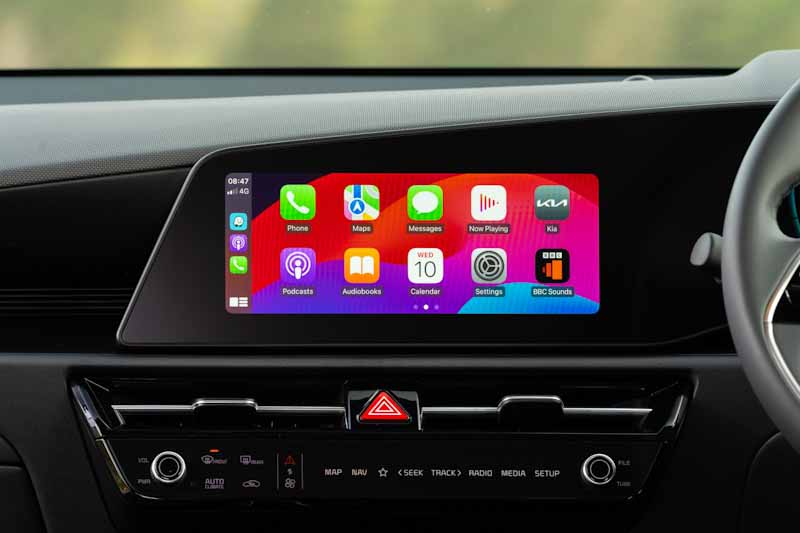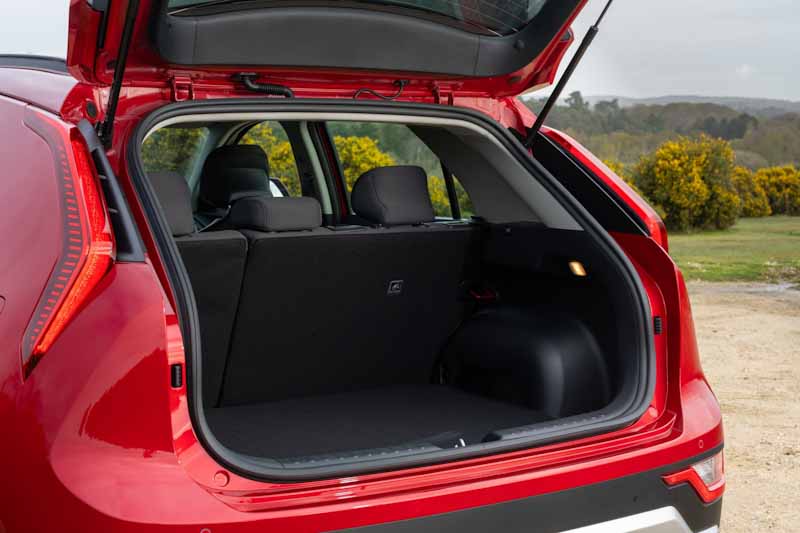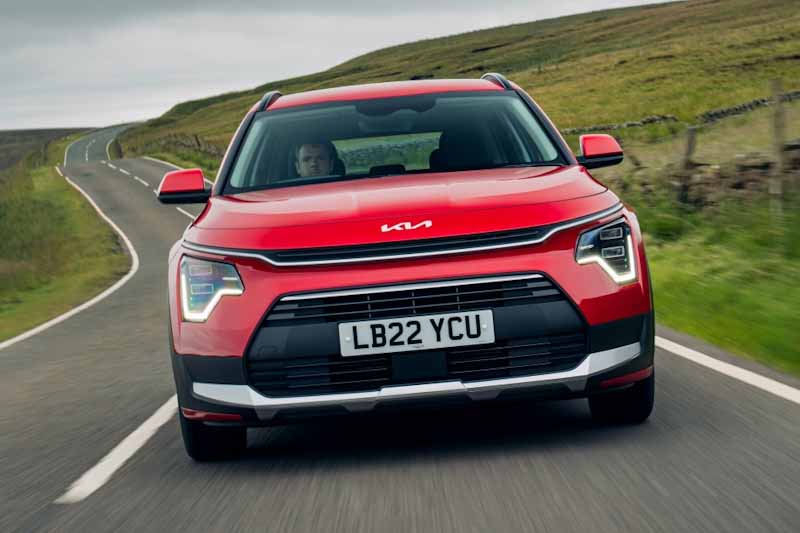
RAC sale – up to 33% off*
• Roadside cover from £5.29 a month†
• We get to most breakdowns in 60 mins or less
• Our patrols fix 4/5 breakdowns on the spot

The second-generation Kia Niro is a refined and practical family SUV. But should you buy one? Dan Powell finds out.
Things you'll like
- Comfortable, spacious interior
- Low running costs
- Impressive in-car tech
Things to consider
- Rivals are more engaging to drive
- Sluggish straight-line performance
- Rear seats don't slide back and forth
What is the Kia Niro Hybrid?
The Kia Niro Hybrid is what some family car buyers would describe as a ‘safe bet’. Easy to drive, cheap to run and backed by Kia’s comprehensive seven-year or 100,000-mile warranty, the Niro Hybrid is a car that promises many years of hassle-free motoring.
The original Kia Niro Hybrid (2016 – 2021) was a car that put the South Korean carmaker on the map for SUV buyers, thanks to its laid-back driving dynamics, spacious cabin and low running costs. But not everyone was smitten by its functional interior and bland styling.

This, the second-generation Kia Niro, is a different proposition with its futuristic styling and classier cabin giving it the look and feel of a much more accomplished car.
That’s not to say the spirit of the first-gen Niro is banished - far from it. Look under the swish exterior of the latest Niro Hybrid and you’ll find a car that majors on practicality, comfort and (most importantly) rock bottom running costs.
Inspired by the HabaNiro concept car that wowed visitors at the 2019 New York Auto Show, the second-generation Niro is a bold SUV that couldn’t look any more different to its predecessor. The futuristic makeover continues inside, with the Niro getting a redesigned cabin that features technology that is genuinely useful and easy to use.
Kia’s decision to revolutionise the Niro is not a vanity exercise; the small SUV class is one of the most competitive in the automotive world and the Niro has stiff competition from the Volkswagen Tiguan, Peugeot 3008, Toyota C-HR, Skoda Karoq and Hyundai Kona.
Is the bold and value-focused Kia Niro good enough to cut it against the best small SUVs on sale today? Read on to find out.
Verdict: is the Kia Niro Hybrid a good car?
The Kia Niro Hybrid is a strong family SUV that has enough style and substance to take on the best in class. Cheap to run, spacious, comfortable and easy to use, the Niro betters its predecessor on every level. Admittedly, it might not be as engaging to drive as some of its rivals, but the Niro is an excellent all-rounder. If you are looking for an affordable but good quality family SUV, the Niro Hybrid will not disappoint.
Pricing, specs & rivals
At the time of writing (May 2025), the Kia Niro 1.6 petrol hybrid range starts from £30,270 for an entry-level model in ‘2’ trim. That’s almost £700 less than the Skoda Karoq with the 1.0 TSI petrol engine and £1400 below the starting price point of the Toyota C-HR 1.8 petrol hybrid.
Unlike its rivals, Kia doesn’t offer a huge array of optional extras with its cars. This means there isn’t a great deal of choice when it comes to personalisation. But given the Niro Hybrid is well equipped as standard, we don’t think this will be an issue for the majority of family car buyers.
The ‘2’ model comes with 16-inch alloy wheels, automatic halogen headlights, LED rear lights, roof rails, parking sensors and a rear-view camera, along with a 10.25-inch touchscreen infotainment system with navigation.
We’d recommend spending extra on the mid-spec ‘3’ version. It starts from £32,540 and adds LED headlights, 18-inch alloy wheels, front parking sensors, heated front seats, fog lights, wireless phone charging pad, privacy glass for the rear windows and a powered tailgate.
The top-spec ‘4’ model starts from £35,290 and features a sunroof, artificial leather seat upholstery, ventilated front seats, heated rear seats, head-up windscreen display and a digital instrument binnacle with a 10.25-inch colour screen.
Rivals
The Kia Niro Hybrid competes with the best family SUVs on the market. The Niro is cheaper than the Toyota C-HR, Honda HR-V and roughly the same price as the Renault Symbioz E-Tech.
If you want something cheaper then you may want to consider the compact but capable Toyota Yaris Cross hybrid. If you want a petrol-only family SUV, the Skoda Karoq and SEAT Arona are also available.
Kia Niro Hybrid: Interior comfort, quality & technology
The interior of the Kia Niro Hybrid represents a significant jump forward from the first-gen Niro. The dashboard has an aesthetically pleasing and practical layout, with a central screen that blends into the instrument binnacle.
There are lots of high quality and soft touch materials too, while everything has a sturdy feel that gives you confidence it’s been built to last.
The cabin isn’t as plush as the Skoda Karoq, but we rate the Niro as one of the best SUVs for comfort. All versions have a height adjustable driver’s seat and the firm padding and large side bolsters provide plenty of support.
The mid-spec ‘3’ model includes electric seat adjustment and adjustable lumbar support, along with heating for the front seats and steering wheel.
The large windows and high roofline give the Niro the feel of a much larger car, while rear parking sensors and reversing camera (standard on all models) calms any anxieties you may have when it comes to parking or performing a three-point turn.

Infotainment, sat-nav, stereo and connectivity
The infotainment system in the Niro Hybrid blends cutting edge tech with a user-friendly interface that makes it surprisingly easy to use.
All versions get a 10.25-inch touchscreen with satellite navigation, which is positioned high up on the dashboard so it can be read without the need to divert your eyes away from the road ahead.
The infotainment system has an intuitive operating system, with crisp graphics, prompt screen changes and shortcut buttons for key controls.
A multimode touch panel is positioned below the infotainment screen, with the option to alternate between audio and ventilation functions. You also get to dials to adjust the temperature and audio volume.
You can mirror your mobile phone display on the car’s infotainment screen via Apple CarPlay or Android Auto, but you do need to plug your phone in to access this (which is a shame when some of the Niro’s rivals are moving to wireless smartphone mirroring).
Most of the in-car infotainment functions can be adjusted or switched via the buttons on the steering wheel.
The Niro model ‘2’ and ‘3’ feature a 4.2-inch screen behind the steering wheel, which shows the vehicle’s speed, fuel level, battery charge, temperature and other key metrics.
The range-topping ‘4’ has a head-up display on the windscreen and a smart 10.25-inch cluster screen which sweeps across the instrument binnacle and merges into the infotainment screen at the centre of the dashboard.
A pair of USB-C ports are installed in the back, which means rear passengers can power mobile devices while you’re on the move. Niro models ‘3’ and ‘4’ also get rear ventilation ducts, installed within the back of the centre console.
How practical is the Kia Niro Hybrid?
The Kia Niro is a practical and comfortable family car. Measuring 1.8m wide and 4.4m long, it is similar in size to the Toyota C-HR. However, thanks to Kia’s clever design, the Niro has a longer wheelbase that provides more interior space.
The front seats are extremely comfortable, with firm padding and a wide seat base that provides excellent support. In the back there is lots of head and legroom for two tall passengers to stretch out and relax.
The only area where the Niro disappoints is in the centre rear seat, which is narrow and lacking in legroom due to the raised floor. This means it is only suitable for short journeys for an adult. However, the Niro will comfortably accommodate three children across the rear bench.
Storage and bootspace
The Kia Niro Hybrid offers 451 litres of boot space, which is more than the Toyota C-HR, SEAT Arona and Toyota Yaris Cross, but less than the 500+ litres you’ll get in a Skoda Karoq.
The Niro is user-friendly, with an adjustable boot floor that makes it simple to load/unload bulky items or a child’s pushchair without having to overextend your back. The fabric parcel shelf can also be stored on the boot floor if you need to use the full height of the loadspace.

There are lots of smart storage points in the cabin, too. The front cubby box can be used as a pair of cupholders or a storage space at the press of a button.
The door pockets are a good size, and all versions of the Niro get a wireless charging pad. There is also a useful area under the centre armrest for storing loose items.
Performance & drive: What is the Kia Niro Hybrid like on the road?
The Kia Niro Hybrid is a car that focuses on comfort, efficiency and practicality.
Power is sent to the front-wheel via a four-cylinder 1.6-litre GDi petrol engine, linked to a single electric motor and 1.32kWh battery. Combined, they’ll produce 125hp, covering 0-62mph in 11.3 seconds.
As with the best hybrid cars, the Niro is driven by the electric motor, with the engine acting as a generator to charge the battery. The Niro is automatic only, with power distributed by a six-speed dual-clutch transmission.
As you pull away, the Niro Hybrid runs on electric power and will continue to do so until it reaches 15mph or the battery charge runs out of charge (and this is when the engine kicks in).
The Niro is at its best when driven with an eco-focused mindset, with a gentle approach resulting in a smooth driving experience.
At low speeds with a soft throttle touch, the Niro wafts along in near-silence which makes it a relaxing car to around town.
There are two driving modes - eco or sport - and most drivers will choose the default eco setting for everyday driving.
Sport mode firms up the steering and sharpens the throttle response, but we are not sure it makes the Niro any more enjoyable to drive as the engine can become quite vocal under heavy acceleration.
With 0-62mph taking 11.3 seconds, the Kia Niro Hybrid lags behind its rivals when it comes to straight-line performance. Both versions of the Toyota C-HR are quicker, with the 1.8 hybrid taking 11 seconds to hit 62mph while the 2.0 hybrid lowers that to 8.2 seconds.
Power, 0-62mph times
- Kia Niro Hybrid: 125hp / 11.3 seconds
Ride and handling
If you are looking for a smooth, quiet and comfortable family SUV then the Niro Hybrid is unlikely to disappoint.
The ‘2’ version provides the best ride quality, thanks to its 16-inch wheels and deep profile tyres absorbing most lumps and bumps in the road. Higher spec models on 18-inch wheels don’t make huge sacrifices in regard to comfort, but potholes and speed bumps are more noticeable.
The Niro Hybrid isn’t designed for high octane thrills, but the front-wheel drive set-up provides plenty of grip and the accurate steering makes it easy to tackle a series of twists and turns with confidence.
Noise and refinement
The Niro Hybrid is a car that majors on refinement, particularly at urban speeds. The hybrid system glides along in near-silence and the engine will only kick in when the battery is depleted or you press the accelerator pedal hard.
Road and wind noise are kept low at a cruise and the Niro is a pleasant motorway companion, with the hybrid system humming along at 70mph.

Euro NCAP: is the Kia Niro Hybrid a safe car?
The Kia Niro Hybrid is a safe family car, scoring a maximum five stars when it was crash tested by Euro NCAP in 2022.
The Niro received an impressive 91% score for adult protection and 84% for child occupant protection.
The cheapest Kia Niro Hybrid in ‘2’ spec gets rear parking sensors, lane departure warning and automatic emergency breaking with car, pedestrian, cyclist and junction detection.
The mid-spec ‘3’ model adds blind-spot collision warning, front parking sensors and a safe exit warning system that will warn the driver of approaching vehicles when they or one of the passengers opens a door.
A rear-cross traffic alert system is also fitted, warning the driver of approaching traffic when reversing out of a parking bay or driveway.
Fuel economy and running costs
The Kia Niro Hybrid is a very efficient car. The entry-level ‘2’ version is the best for fuel economy on paper, with its official economy averaging at 64.2mpg. The ‘3’ and ‘4’ models use marginally more fuel according to the official figures, with Kia claiming 61.4mpg.
That compares well against the Toyota C-HR, with the most efficient version (1.8 hybrid) returning up to 57.6mpg.
The Renault Symbioz E-Tech promises 61.4mpg while the 1.0 petrol version of the Skoda Karoq will officially return up to 44.8mpg - showing the benefits of hybrid propulsion.
The Niro Hybrid is backed by Kia’s comprehensive seven year or 100,000 miles warranty (whichever comes first), which means you have peace of mind that you’ll be covered if anything serious goes wrong.
How much does the Kia Niro Hybrid cost to insure?
The Kia Niro Hybrid starts in insurance group 18 for the ‘2’ model and climbs to group 20 for the ‘3’ and ‘4’ versions.
The Toyota C-HR also sits in group 20, while the Skoda Karoq costs significantly less to insure with its insurance ranking starting in group 10.
Kia Niro Hybrid FAQs
Is it worth buying a Kia Niro Hybrid?
The Kia Niro Hybrid is a great family car, with a long warranty and an efficient hybrid powertrain. All versions get touchscreen tech with satellite navigation as standard, while the Niro’s large boot and comfortable ride quality make it excellent for long trips.
Is the Kia Niro Hybrid self-charging?
Yes, the Kia Niro Hybrid is a self-charging car. The hybrid powertrain combines a petrol engine with an electric motor and a battery. The vehicle can run on electric power or a combination of electric and petrol power to ensure emissions and fuel use are kept to a minimum.
Does the Kia Niro Hybrid have a large boot?
The Kia Niro Hybrid has one of the largest boots in its SUV class, with 451 litres available with the rear seats upright and 1445 litres when the rear seats are folded.












